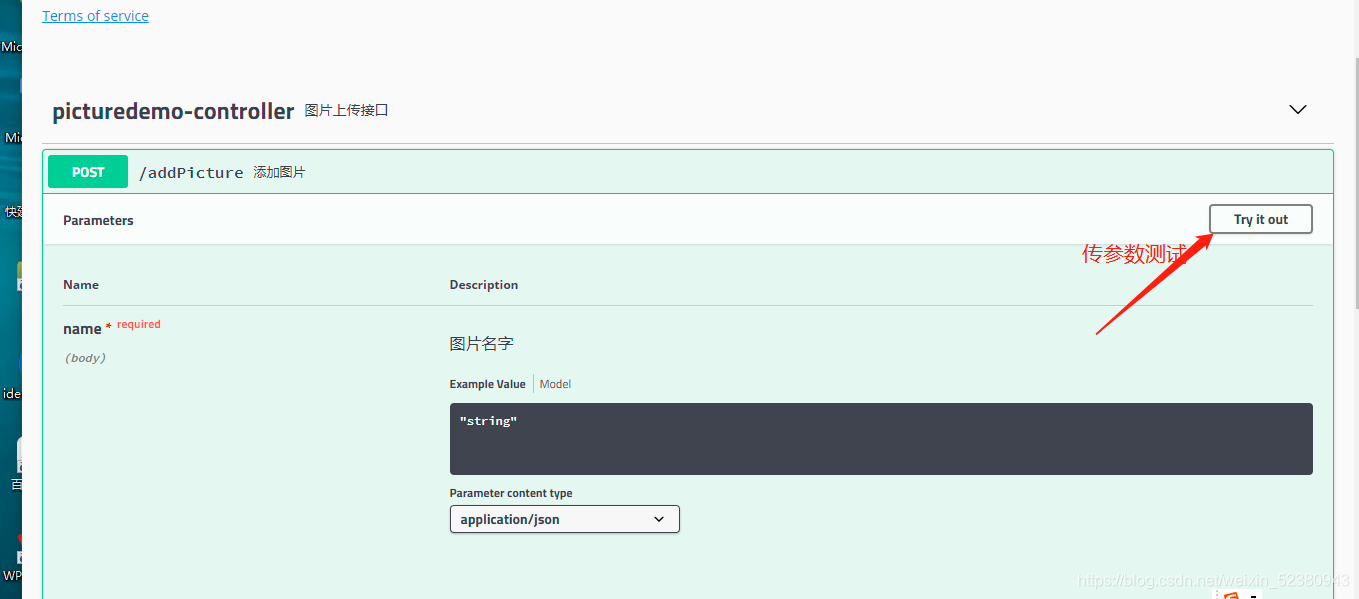1.添加maven依赖
<!-- https://mvnrepository.com/artifact/io.springfox/springfox-swagger-ui -->
<dependency>
<groupId>io.springfox</groupId>
<artifactId>springfox-swagger-ui</artifactId>
<version>2.9.2</version>
</dependency>
<!-- https://mvnrepository.com/artifact/io.springfox/springfox-swagger2 -->
<dependency>
<groupId>io.springfox</groupId>
<artifactId>springfox-swagger2</artifactId>
<version>2.9.2</version>
</dependency>
2.添加Swagger2配置类
import org.springframework.context.annotation.Bean;
import org.springframework.context.annotation.Configuration;
import springfox.documentation.builders.ApiInfoBuilder;
import springfox.documentation.builders.PathSelectors;
import springfox.documentation.builders.RequestHandlerSelectors;
import springfox.documentation.service.ApiInfo;
import springfox.documentation.spi.DocumentationType;
import springfox.documentation.spring.web.plugins.Docket;
import springfox.documentation.swagger2.annotations.EnableSwagger2;
@Configuration
@EnableSwagger2
public class Swagger2Configuration {
//api接口文档包扫描路径
public static final String SWAGGER_SCAN_BASE_PACKAGE = "com.example.studydemo";
public static final String VERSION = "1.0.0";
@Bean
public Docket createRestApi() {
return new Docket(DocumentationType.SWAGGER_2)
.apiInfo(apiInfo())
.select()
.apis(RequestHandlerSelectors.basePackage(SWAGGER_SCAN_BASE_PACKAGE))
.paths(PathSelectors.any()) // 可以根据url路径设置哪些请求加入文档,忽略哪些请求
.build();
}
private ApiInfo apiInfo() {
return new ApiInfoBuilder()
.title("图片查看添加测试服务") //设置文档的标题
.description("图片查看添加测试服务 API 接口文档") // 设置文档的描述
.version(VERSION) // 设置文档的版本信息-> 1.0.0 Version information
.termsOfServiceUrl("http://www.baidu.com") // 设置文档的License信息->1.3 License information
.build();
}
}
3.创建api接口
import io.swagger.annotations.Api;
import io.swagger.annotations.ApiImplicitParam;
import io.swagger.annotations.ApiImplicitParams;
import io.swagger.annotations.ApiOperation;
import org.springframework.stereotype.Controller;
import org.springframework.web.bind.annotation.*;
@Api(description = "图片上传接口")
@RestController
public class PicturedemoController {
@ApiOperation(value = "没有参数的查看")
@RequestMapping(value = "/findAll",method = RequestMethod.GET)
@ResponseBody
public String findAll(){
return "查看完成";
}
@ApiOperation(value = "添加图片")
@RequestMapping(value = "/addPicture",method = RequestMethod.POST)
@ApiImplicitParam(name = "name",value = "图片名字",required = true)
@ResponseBody
public String addPicture(@RequestBody String name){
return name;
}
@ApiOperation(value = "添加图片全部信息")
@RequestMapping(value = "/addPictures",method = RequestMethod.POST)
@ApiImplicitParams({
@ApiImplicitParam(name = "name",value = "图片名字",dataType = "String",paramType = "query",required = true),
@ApiImplicitParam(name = "size",value = "图片大小",dataType ="String",paramType = "query",required = true)
})
@ResponseBody
public String addPictures(@RequestBody String name, String size){
return "图片名称"+name+"大小"+size;
}
}
这里提供一个配置类,首先通过@EnableSwagger2注解启用Swagger2,然后配置一个Docket 类,这个类中,配置映射路径和要扫描的接口的位置,在apiInfo中,主要配置一下Swagger2文档网站的信息,例如网站的title,描述等信息,使用的协议等等。
这样!Swagger2就算配置成功了,非常方便。
启动项目,输入http://localhost:8889/swagger-ui.html#,能够看到下面页面,说明已经配置成功了:端口号根据自己的项目来,我的项目配置的是8889







**注:swagger2注解功能**
@Api注解可以用来标记当前Controller的功能。
@ApiOperation注解用来标记一个方法的作用。
@ApiImplicitParam注解用来描述一个参数,可以配置参数的中文含义,也可以给参数设置默认值,这样在接口测试的时候可以避免手动输入。
如果有多个参数,则需要使用多个@ApiImplicitParam注解来描述,多个@ApiImplicitParam注解需要放在一个@ApiImplicitParams注解中。
需要注意的是,@ApiImplicitParam注解中虽然可以指定参数是必填的,但是却不能代替@RequestParam(required = true),前者的必填只是在Swagger2框架内必填,抛弃了Swagger2,这个限制就没用了,所以假如开发者需要指定一个参数必填,@RequestParam(required = true)注解还是不能省略。
如果参数是一个对象(例如上文的更新接口),对于参数的描述也可以放在实体类中。例如下面一段代码:
@Data
@Schema(description = "新增会员")
public class AccountAddReq {
@ApiModelProperty(name = "type", value = "注册类型", required = true)
private Integer type;
@ApiModelProperty(name = "mobile", value = "注册手机号", required = true)
@Pattern(regexp = PatternConstant.MOBILE_PATTERN)
@NotEmpty(message = "注册手机号不能为null")
private String mobile;
@ApiModelProperty(name = "password", value = "密码", required = true)
@NotEmpty(message = "密码不能为空")
private String password;
@ApiModelProperty(name = "code", value = "验证码", required = true)
@NotEmpty(message = "验证码不能为空")
private String code;
}
Swagger2注解详解
1、@Api :请求类的说明
@Api:放在请求的类上,与 @Controller 并列,说明类的作用,如用户模块,订单类等。
tags=“说明该类的作用”
value=“该参数没什么意义,所以不需要配置”
举例:
@Api(tags = "账户模块")
@RestController
@RequestMapping("/api/account")
public class AccountController {
//TODO
}
2、@ApiOperation:方法的说明
@ApiOperation:“用在请求的方法上,说明方法的作用”
value=“说明方法的作用”
notes=“方法的备注说明”
举例:
@ApiOperation(value = "修改密码", notes = "方法的备注说明,如果有可以写在这里")
@PostMapping("/ updatepassword")
public AjaxResult updatePassword(@AutosetParam SessionInfo sessionInfo,
@RequestBody @Valid PasswordModel passwordModel) {
}
3、@ApiImplicitParams、@ApiImplicitParam:方法参数的说明
@ApiImplicitParams:用在请求的方法上,包含一组参数说明
@ApiImplicitParam:对单个参数的说明
name:参数名
value:参数的汉字说明、解释
required:参数是否必须传
paramType:参数放在哪个地方
· header --> 请求参数的获取:@RequestHeader
· query --> 请求参数的获取:@RequestParam
· path(用于restful接口)–> 请求参数的获取:@PathVariable
· body(请求体)–> @RequestBody User user
· form(普通表单提交)
dataType:参数类型,默认String,其它值dataType=“int”
defaultValue:参数的默认值
举例:
@ApiOperation(value="登录",notes="描述----")
@ApiImplicitParams({
@ApiImplicitParam(name="mobile",value="手机号",required=true,paramType="form"),
@ApiImplicitParam(name="password",value="密码",required=true,paramType="form")
})
@PostMapping("/login")
public AjaxResult login(@RequestParam String mobile, @RequestParam String password ){
//TODO
return AjaxResult.OK();
}
单个参数举例
@ApiOperation("根据用户Id删除")
@ApiImplicitParam(name="userId",value="部门id",required=true,paramType="query")
@GetMapping("/delete")
public AjaxResult delete(String depId) {
//TODO
}
4、@ApiResponses、@ApiResponse:方法返回值的说明
@ApiResponses:方法返回对象的说明
@ApiResponse:每个参数的说明
code:数字,例如400
message:信息,例如"请求参数没填好"
response:抛出异常的类
举例:
@ApiOperation(value = "设置密码", notes = "方法的备注说明,如果有可以写在这里")
@ApiResponses({
@ApiResponse(code = 400, message = "请求参数没填好"),
@ApiResponse(code = 404, message = "请求路径找不到")
})
@PostMapping("/updatepassword")
public AjaxResult updatepassword(@AutosetParam SessionInfo sessionInfo,
@RequestBody @Valid PasswordModel passwordModel) {
//TODO
}
6. @ApiModelProperty:用在JavaBean的属性上面,说明属性的含义
@ApiModel和 @ApiModelProperty举例:
@ApiModel("修改密码所需参数封装类")
public class PasswordModel
{
@ApiModelProperty("用户Id")
private String accountId;
//TODO
}
---------加油每一天------






















 1万+
1万+











 被折叠的 条评论
为什么被折叠?
被折叠的 条评论
为什么被折叠?








